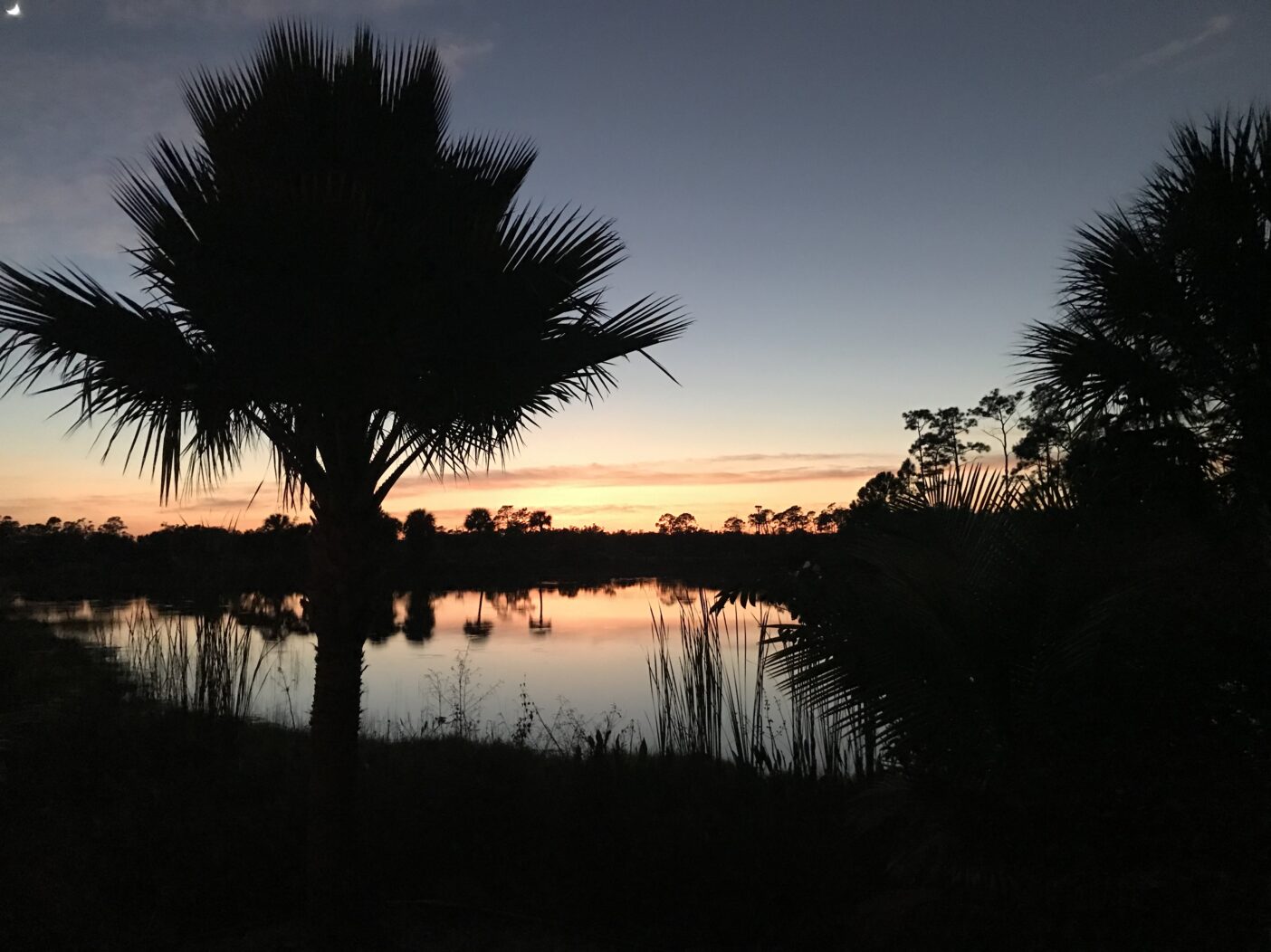
It’s likely that many of you have experienced Naples Botanical Garden by day — with its expansive green spaces, plush petals set against smooth palms, splashes of pink blooms nestled among shades of green, and a host of buzzing bees and chattering birds.
But what about the side you haven’t seen — the one that wakens at night and reclaims the Garden? (I’m not talking about Night Lights, despite its fanfare and nocturnal luminescence.)
Instead, I’m talking about the Garden bathed in golden sunlight, as the faces of trees and plants turn a fiery orange, then metamorphose from brown to gray to mere silhouette. If you haven’t seen the Garden after hours, let’s take a nighttime stroll and explore the sights, smells, and sounds that emerge as the sun sets. I’ll also let you in on our new evening offering, so you can experience twilight for yourself.
If you stand in the Scott Florida Garden and train your eyes upward, you’ll spot little blue herons, great egrets, and an occasional colony of white ibis, two dozen or more in their ranks. They glide westward, over Lake Tupke, past the Collier Enterprises South Wetlands Preserve, toward their respective roosting spots.
As darkness blankets the Garden, other senses begin to take hold. Without the distractions of daytime, it’s easier to spot plants that might otherwise go unnoticed.
Demure ivory, butter yellow, and cream blooms dominate the night hours. Take sweet acacia (Vachellia farnesiana), located on the fringes of the Florida Garden, one of our prime spots for sunset viewing. This Florida native tree has hundreds of “green beans,” if you will, dangling from its branches. The tree, in fact, is in the legume (peas and beans) family, and the seed pods replace its flowers — compact yellow puff balls — once they are pollinated. This year, it bloomed primarily in December and January, but on this breezy February afternoon, a pleasant fragrance still permeates the air in its vicinity.

Horticulture Volunteer Coordinator Andee Naccarato and I meander up the hill into the Florida Garden, closer to Ed’s and Judy’s Pavilion Pool. She points out the spot where some aquatic night bloomers — such as Jameson’s waterlily (Nymphaea jamesoniana) typically reside. By day, their buds sit closed, flush at the water’s surface, and by night, they smell uncannily like sweet acetone (or rather, fermented fruit left sitting in the fridge too long). Expect to encounter this botanical paradox in the Florida Garden during the summer and early fall months — after all, you can’t take in the sight of its elegant blooms without a whiff of its unsolicited “perfume.”
“You can just smell the Jameson’s waterlily without even putting your nose to it,” Andee says. It’s a fitting coincidence that Andee should serve as a staff resource on this topic; prior to assuming her current role at the Garden, she was senior program specialist at Six Mile Cypress Slough Preserve in Fort Myers, Florida, where she gave full moon walking tours, making her a bit of an expert in nighttime flora.
“We are so visually dominant during the day,” Andee says. “We notice more at night when we’re not distracted by other senses.
“Bold and flashy flowers are usually intended for daytime pollinators,” she continues. “Many colors we see during the day may not show up for a nighttime pollinator, such as a moth or a bat. Big white blooms or strong scents are more likely to stand out at night.”
Just a few paces away, in the Kapnick Caribbean Garden, other unassuming night-fragrant plants, such as the Lady of the Night (Brunfelsia americana), are nestled among bold, attention-seeking neighbors. One of its pollinators is bats. Others, like the night-blooming Epiphyllum oxypetalum, commonly known as Queen of the Night or night-blooming cereus flower, require you to examine the foliage more closely in order to spot. Gardner Morgan Jones, shows me this epiphytic cactus, tucked into the trunk of a Mamey Apple (Mammae americana) fruit tree.
As night wears on and you meander back toward the light of Fogg Café and Kapnick Hall, it’s likely you might pick up on the sounds of night in the Garden. Listen for the “dee-dee-dee” of killdeer, a ground-nesting bird commonly seen in open lawns throughout Southwest Florida, or the high-pitched call of an Eastern screech owl as it carries through the stillness of the night. During winter months, you may even hear the rhythmic “trill” of the Southern toad.

Explore the Garden at sunset and twilight during Garden Nights when we’re open until 8pm, every Wednesday through March 25. You might be surprised at what you’ll discover. And this Wednesday, March 4, pups are invited, too! Get the details on our Garden Nights page.
About the Author
Jenny Fuentes is the Content Manager at Naples Botanical Garden. She is a communications professional with experience in the nonprofit and higher education arenas. It’s the thrill of a good story that keeps her anchored to this profession.

